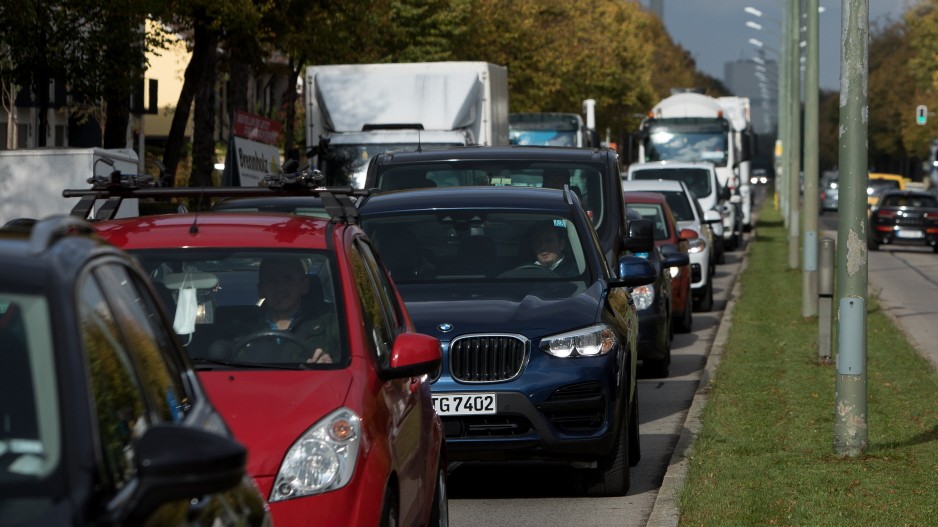The beginning of the corona pandemic a year ago also had a dramatic impact on the volume of traffic in Germany. The everyday traffic jams to or from work? There wasn’t any more. Instead, in larger cities, lanes have been converted into pop-up bike lanes to create more space for cyclists. At the same time, pollution levels fell. Today, a year after the first lockdown, with restrictions and a high proportion of home offices, the consequences can still be felt, even though traffic has again increased significantly compared to 2020.
This is the result of the American company Inrix, which publishes its “Global Traffic Scorecard” released. The German traffic jam capital 2020 is therefore again Munich. Here, road users lose an average of 65 hours a year. The Bavarian capital landed in first place in 2019. The front runner of 2018, Berlin, follows directly behind. Drivers are stuck in traffic jams for 46 hours, followed by Hamburg with 33 hours.
In an international comparison, Munich jumped from 47th place to 20th place. This is also due to the fact that traffic in the Bavarian capital quickly rose back to pre-crisis level. However, the German city is still in relatively good shape. In Bucharest, drivers spent 134 hours a year in traffic jams – that’s five and a half days. Bogota follows closely behind with 133 hours, in Moscow and New York it was 100 hours each.
Each and every German spent an average of 20 hours in traffic jams
The methodology that Inrix uses for its Global Traffic Scorecard is the same as it was in 2019. The company examined anonymised GPS data from 1000 cities in 50 countries around the world. The sources for determining traffic movements in an entire region include networked vehicles, smartphones and navigation devices. 74 cities in Germany were examined. This includes not only the centers, but also the most frequented routes beyond the city center. This results in an exact picture that shows peak times and lost time.
On average, Germans were stuck in traffic jams for 26 hours last year, which corresponds to nationwide losses of 2.3 billion euros or 235 euros per driver. The traffic analysts use the average hourly wage per capita as the basis for calculation, taking into account the costs arising from wasting time and gasoline as well as indirect costs that companies incur – and which they pass on to households in the form of higher prices. Here, too, the pandemic has left its mark: In 2019, there were still 46 hours of traffic jams per driver. This corresponds to a nationwide saving of 500 million euros due to the restricted volume of traffic. In the traffic jam capital of Munich, drivers stayed in slow-moving traffic for 87 instead of 65 hours in 2019, and 66 instead of 46 hours in Berlin.
The most congested street is in Berlin
According to the data analysis, there is also the street with the longest waiting time. The front runner is the Tempelhofer Damm / Mehringdamm (B96) in Berlin on the section between Borussiastraße and Tempelhofer Ufer. The loss of time here is an average of four minutes during peak times. That doesn’t sound like a lot, but it adds up to an annual average of 14 hours. Just behind it is the Schleissheimer Strasse in Munich with a total of 13 hours and the Ratsmühlendamm / Fühlsbüttler Strasse in Hamburg, which takes twelve hours. In 2019, the top three only included road sections in Berlin.
The Global Traffic Scorecard also shows how traffic flows were influenced by the corona pandemic and the measures taken in 2020. In April 2020, the first full month with strict exit and contact restrictions, there were significantly fewer trips to city centers. In Cologne and Munich these fell by almost two thirds compared to February. With the easing in summer, traffic increased again and approached the pre-crisis level. The front runner is again Munich, which reached the level of February in September 2020, in Berlin they were eight percent lower at this time.
The study also shows that the traffic volume in the “soft” lockdown in November and the subsequent tougher restrictions no longer decreased as much as in March and April 2020. Overall, commuters spent the more or less smooth journey in the largest German cities Cities in 2020 will spend between a quarter and a third less time in traffic jams, and the average daily mileage also fell.
Less trips to the city centers
That continues this year. The number of trips to German city centers in February 2021 is still 40 percent below the pre-crisis level in 2020. This picture can be seen in all industrialized nations. In the USA the minus is 44 percent, in Great Britain it is 52 percent less compared to the pre-Corona level.
The traffic decreased particularly in the city centers – due to the high number of people who switched to the home office and because so many restaurants and museums are closed and there are still few entertainment options. “The corona virus is changing the way, when, where and we move,” explains Inrix traffic analyst Bob Pishue. “Government restrictions and the increasing spread of the virus have changed travel behavior almost overnight.” That is unlikely to change this year either.
– .


